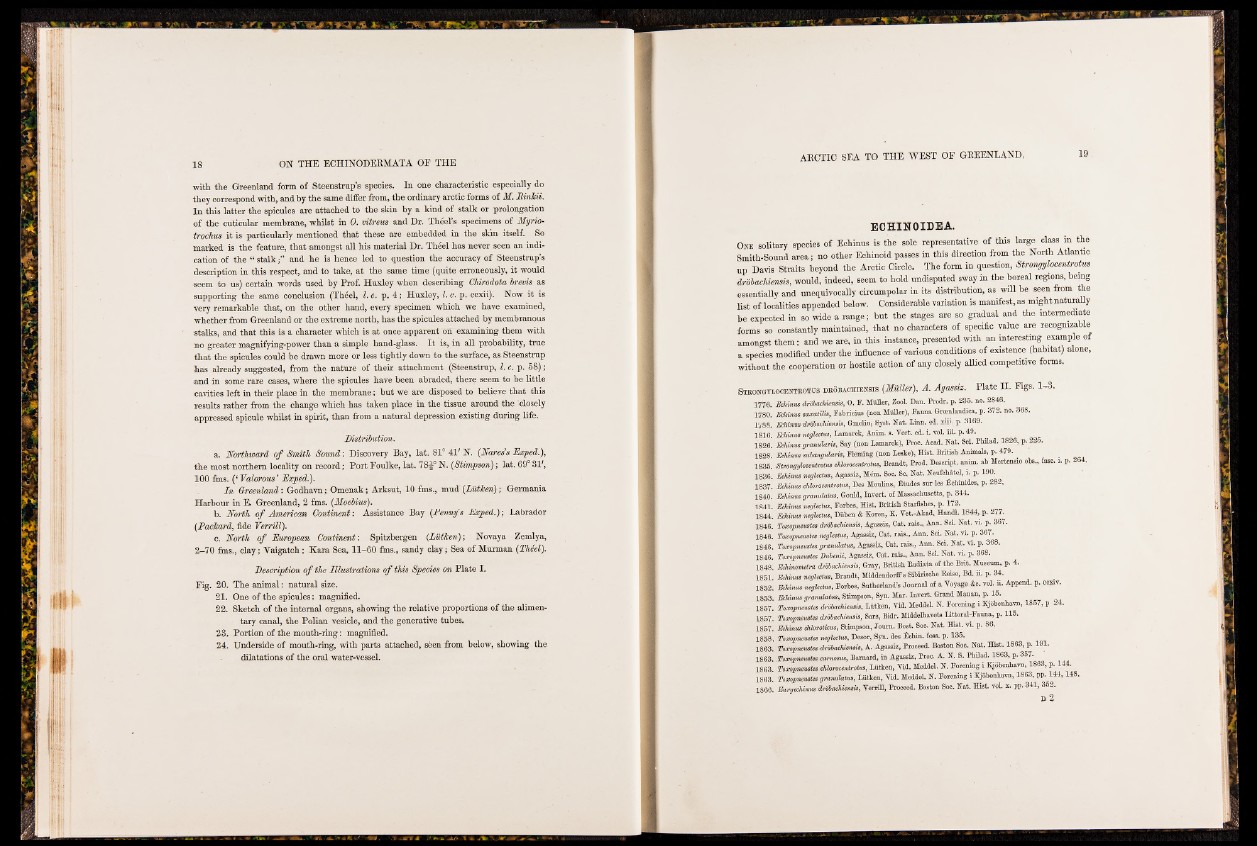
18 ON THE ECHINODERMATA OF THE
with the Greenland form of Steenstrup’s species. In one characteristic especially do
they correspond with, and by the same differ from, the ordinary arctic forms of M. Binkii.
In this latter the spicules are attached to the skin by a kind of stalk or prolongation
of the cuticular membrane, whilst in 0. vitreus and Dr. Theel’s specimens of Myrio-
trochus it is particularly mentioned that these are embedded in the skin itself. So
marked is the feature, that amongst all his material Dr. Theel has never seen an indication
of the “ s ta lk ” and he is hence led to question the accuracy of Steenstrup’s
description in this respect, and to take, at the same time (quite erroneously, it would
seem to us) certain words used by Prof. Huxley when describing Chirodota brevis as
supporting the same conclusion (Theel, l. c. p. 4; Huxley, l. c. p. ccxii). Now it is
very remarkable that, on the other hand, every specimen which we have examined,
whether from Greenland or the extreme north, has the spicules attached by membranous
stalks, and that this is a character which is at once apparent on examining them with
no greater magnifying-power than a simple hand-glass. I t is, in all probability, true
that the spicules could be drawn more or less tightly down to the surface, as Steenstrup
•has already suggested, from the nature of their attachment (Steenstrup, l. c. p. 58);
and in some rare cases, where the spicules have been abraded, there seem to be little
cavities left in their place in the membrane; but we are disposed to believe that this
results rather from the change which has taken place in the tissue around the ‘closely
appressed spicule whilst in spirit, than from a natural depression existing during life.
Distribution.
a. Northward o f Smith Sound: Discovery Bay, lat. 81° 41' N. (Nares's Exped.),
the most northern locality on record; Port Foulke, lat. 78^° N. (Stimpson); lat. 69° 3F,
100 fins. (‘ Valorous ’ Exped.).
In Greenland: Godhavn; Omenak; Arksut, 10 fms., mud’ (Liitlcen); Germania
Harbour in E. Greenland, 2 fms. (Moebius).
b. North o f American Continent: Assistance Bay (Penny's Exped.); Labrador
(Packard, fide Verrill).
c. North o f European Continent: Spitsbergen (Liitken); Novaya Zemlya,
2-70 fms., clay; Yaigatch; Kara Sea, 11-60 fms., sandy clay; Sea of Murman (Theel).
Description o f the Illustrations o f this Species on Plate I.
Fig. 20. The animal: natural size.
21. One of the spicules: magnified.
22. Sketch of the internal organs, showing the relative proportions of the alimentary
canal, the Polian vesicle, and the generative tubes.
23. Portion of the mouth-ring: magnified.
24. Underside of mouth-ring, with parts attached, seen from below, showing the
dilatations of the oral water-vessel.
ECHINOIDEA.
One solitary species of Echinus is the sole representative of this large class in the
Smith-Sound area; no other Echinoid passes in this direction from the North Atlantic
up Davis Straits heyond the Arctic Circle. The form in question, Strmgylocentrotm
dröiachimm, would, indeed, seem to hold undisputed sway in the boreal regions, being
essentially and unequivocally circumpolar in its distribution, as will be seen from the
list of localities appended below. Considerable variation is manifest, as might naturally
be expected in so wide a range; but the stages are so gradual and the intermediate
forms so constantly maintained, that no characters of. specific value are recognizable
amongst them ; and we are, in this instance, presented with an interesting example of
a species modified under the influence of various conditions of existence (habitat) alone,
without the cooperation or hostile action of any closely allied competitive|||nn*.
Stbofgtlocenteotus drobachiensis (Müller), A. Agassiz. Plate H. Figs. 1~3,
1776. Echinus drobachiensis, O. F. MiUler, Zool. Dan. Prodr. p. 235. no. 2846.
1780. Echinus saxatilis, Fabridus (non Müller), Fauna Groenlandica, p. 372. no. 368.
1788. Echinus drobachiensis, Gmelin, Syst. Nat. Linn. ed. xiii. p. 3169.
1816. Echinus neglectus, Lamarck, Anim. s. Yert. ed. i. vol. iii. p. 49.
1826. Echinus granularis, Say (non Lamarck), Proc. Acad. Nat. Soi. Phüad. 1826, p. 225,
1828. Echinus subangularis, Fleming (non Leake), Hast. British Animals, p. 479. .
1835. Strongylocentrotus chlorocentrotus, Brandt, Prod. Descript, anim. ab Mertensio obs., fasc. i. p. 264.
1836. Echinus neglectus, Agassiz, Mém. Soc. Sc, Nat. Neufchâtel, i. p. 190.
1837. Echinus chlorocmtrotus, Des Moulins, Études sur les Échinides, p, 282,
1840. Echinus granulatus, Gould, Invert, of Massachusetts, p. 344.
1841. Echinus neglectus, Forbes, Hist. British Starfishes, p. 172.
1844. Echinus neglectus, Düben & Koren, K, Yet.-Akad. Handl. 1844, p. 277.
1846. Toxopneustes drobachiensis, Agassiz, Cat. rais., Ann. Soi. Nat. vi. p. 367.
1846. Toxopneustes neglectus, Agassiz, Cat. rais., Ann. Sd. Nat. vi. p. 367.
1846. Toxopneustes gramdatus, Agassiz, Cat. rais., Ann. Soi. Nat. vi. p. 368.
1846. Toxopneustes Dubenii, Agassiz, Cat. rais., Ann. Sei. Nat. vi. p. 368.
1848. Echinometra drobachiensis, Gray, British Badiata of the Brit. Museum, p. 4.
1851. Echinus neglectus, Brandt, Middendorff’s Sibirische Boise, Bd. ii. p. 34.
1852. Echinus neglectus, Forbes, Sutherland’s Journal of a Voyage &c. vol. ii. Append, p. ecxiv.
1853. Echinus granulatus, Stimpson, Syn. Mar. Invert. Grand Manan, p. 15,
1857. Toxopneustes drobachiensis, Lütken, Yid. Meddel. N. Forening i Kjöbenhavn, 1857, p 24.
1857. Toxopneustes drobachiensis, Sars, Bidr. Middelhavets Littoral-Fauna, p. 115.
1857. Echinus chloroticus, Stimpson, Joum. Bost. Soc. Nat. Hist. vi. p. 86.
1858. Toxopneustes neglectus, Desor, Syn. des Éohin. foss. p. 135.
1863. Toxopneustes drobachiensis, A. Agassiz, Proceed. Boston Soc. Nat. Hist. 1863, p. 191.
1863. Toxopneustes camosus, Barnard, in Agassiz, Proc. A. N. S. Philad. 1863, p. 357.
1863. Toxopneustes chlorocentrotus, Lütken, Yid, Meddel. N. Forening i Kjöbenhavn, 1863, p.
1863. Toxopneustes gramdatus, Lütken, Yid. Meddel, N. Forening i Kjöbenhavn, 1863, pp. 1 4 4 ,1 4 8 ,
1866. Euryechmus drobachiensis, Yerrttl, Proceed. Boston Soc. Nat. Hist. vol. x. pp. 341, 352.
D 2